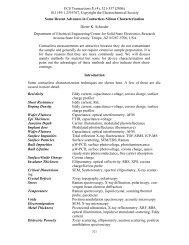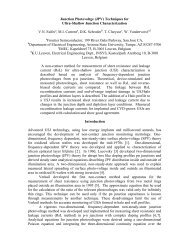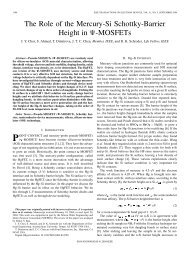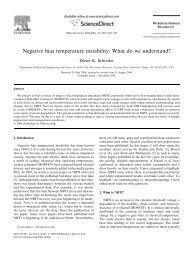Low-Frequency Noise in Near-Fully Depleted TFSOI MOSFET's
Low-Frequency Noise in Near-Fully Depleted TFSOI MOSFET's
Low-Frequency Noise in Near-Fully Depleted TFSOI MOSFET's
Create successful ePaper yourself
Turn your PDF publications into a flip-book with our unique Google optimized e-Paper software.
40 IEEE ELECTRON DEVICE LETTERS, VOL. 19, NO. 2, FEBRUARY 1998<br />
<strong>Low</strong>-<strong>Frequency</strong> <strong>Noise</strong> <strong>in</strong><br />
<strong>Near</strong>-<strong>Fully</strong>-<strong>Depleted</strong> <strong>TFSOI</strong> MOSFET’s<br />
Jeffrey A. Babcock, Dieter K. Schroder, and Y<strong>in</strong>g-Che Tseng<br />
Abstract— <strong>Low</strong>-frequency (1=f ) noise <strong>in</strong> near-fully-depleted<br />
Th<strong>in</strong>-Film Silicon-On-Insulator (<strong>TFSOI</strong>) CMOS transistors designed<br />
for sub-1-V applications is <strong>in</strong>vestigated <strong>in</strong> the subthreshold<br />
region, l<strong>in</strong>ear region, and saturation region of operation for the<br />
first time. The noise <strong>in</strong> these surface-channel devices is composed<br />
of a bias <strong>in</strong>variant 1=f component and a bias dependent<br />
generation-recomb<strong>in</strong>ation (G/R) component that becomes enhanced<br />
<strong>in</strong> the subthreshold region of operation for both n- and p-<br />
channel MOSFET’s. Results presented <strong>in</strong> this letter are consistent<br />
with the noise be<strong>in</strong>g dom<strong>in</strong>ated by a number fluctuation model.<br />
These results demonstrate that the bias <strong>in</strong>dependent 1=f noise<br />
spectrum of the n-channel <strong>TFSOI</strong> MOSFET is comparable to<br />
the 1=f noise level found <strong>in</strong> conventional bulk silicon submicron<br />
CMOS fabrication processes.<br />
I. INTRODUCTION<br />
TECHNOLOGIES capable of deliver<strong>in</strong>g suitable RFmixed<br />
mode IC operation at supply voltages of 1.0 V<br />
will become <strong>in</strong>creas<strong>in</strong>gly critical for the rapidly grow<strong>in</strong>g<br />
portable communications market [1], [2]. Recently, Th<strong>in</strong>-Film<br />
Silicon-On-Insulator (<strong>TFSOI</strong>) has emerged as a key technology<br />
capable of operat<strong>in</strong>g at supply voltages of 1.0 V, while<br />
ma<strong>in</strong>ta<strong>in</strong><strong>in</strong>g performance advantages for low-power, low-cost,<br />
mixed-mode RFIC portable communications applications. This<br />
has been recently demonstrated by a sub-1-V microcontroller<br />
CPU which achieved a 2 improvement <strong>in</strong> clock frequency<br />
when compared to bulk silicon performance, while also<br />
atta<strong>in</strong><strong>in</strong>g the high yield and low production costs required<br />
for large scale manufacturability [3], [4]. One of the critical<br />
measures of the electrical performance of a device is the<br />
low-frequency (LF) noise produced dur<strong>in</strong>g circuit operation<br />
because it places a fundamental limit on signal detection<br />
and spectral purity. For low-voltage analog circuit operation,<br />
which dictates tighter control on circuit performance, LF noise<br />
becomes even more important. This is especially critical <strong>in</strong><br />
low-power RF applications such as mixers and VCO’s where<br />
noise becomes up-converted to the higher frequencies<br />
as phase noise [5]. Although much work has been done on<br />
<strong>TFSOI</strong> [6]–[8], very little exists on the noise properties of these<br />
devices [9]–[13]. In this letter, we give the first results on the<br />
noise properties of n- and p-channel MOSFET’s designed for<br />
sub-1-V RF mixed-mode circuit applications [3], [14].<br />
Manuscript received May 28, 1997.<br />
J. A. Babcock and D. K. Schroder are with the Center for Solid-State<br />
Electronics Research, Department of Electrical Eng<strong>in</strong>eer<strong>in</strong>g, Arizona State<br />
University, Tempe, AZ 85287-5706 USA.<br />
Y.-C. Tseng is with the Department of Electrical Eng<strong>in</strong>eer<strong>in</strong>g, University<br />
of California, Los Angeles, CA 90095 USA.<br />
Publisher Item Identifier S 0741-3106(98)01359-7.<br />
Fig. 1.<br />
Magnitude of the measured <strong>in</strong>put-referred gate voltage noise power<br />
spectrum at 1.0 Hz for a small area (A Gate =1025020:45 m 2 ) and larger<br />
area (A Gate = 1002 50 2 0:45 m 2 ) n-channel MOSFET as a function of<br />
V GS 0 V T : Note the <strong>in</strong>crease <strong>in</strong> noise <strong>in</strong> the subthreshold region of operation<br />
is due to the appearance of G/R noise superimposed on the fundamental 1=f<br />
noise of the device.<br />
II. DEVICE TECHNOLOGY<br />
Fabrication of the CMOS technology on <strong>TFSOI</strong> have been<br />
described by Huang et al. [15]. The technology is based on<br />
a fully manufacturable process with 0.5- m CMOS devices<br />
[16] built on SIMOX substrates with a nom<strong>in</strong>al Si thickness<br />
of 1000 Å and buried oxide thickness of 4000 Å. Titanium silicide<br />
source dra<strong>in</strong> contacts are used to enhance high-frequency<br />
performance. Gate oxide thickness is 105 Å. Polysiliconbuffered<br />
LOCOS field isolation is used to isolate MOS devices<br />
[4].<br />
LF noise measurements were made us<strong>in</strong>g a HP 3561A<br />
Dynamic Signal Analyzer with the gate electrode of the MOS-<br />
FET ac shorted to ground. A wire wound load resistor was<br />
adjusted to achieve the desired dra<strong>in</strong>-to-source voltage<br />
<strong>Noise</strong> signal amplification was provided by a EG&G <strong>Low</strong><br />
<strong>Noise</strong> Amplifier model 113. An <strong>in</strong>-house specialized computer<br />
program controlled the equipment <strong>in</strong>terface and calculated<br />
the <strong>in</strong>put equivalent gate voltage noise source based<br />
on the device transconductance<br />
, the<br />
device output conductance<br />
, and the<br />
load resistance values [17].<br />
III. RESULTS<br />
CMOS <strong>TFSOI</strong> device characteristics have been described <strong>in</strong><br />
[16]. <strong>Noise</strong> characteristics of these transistors were measured<br />
0741–3106/98$10.00 © 1998 IEEE
BABCOCK et al.: LOW-FREQUENCY NOISE IN NEAR-FULLY-DEPLETED <strong>TFSOI</strong> MOSFET’S 41<br />
Fig. 2. Equivalent <strong>in</strong>put-referred gate noise power spectral density multiplied by frequency (SV G2 f ) versus measured frequency for a <strong>TFSOI</strong> n-channel<br />
MOSFET biased <strong>in</strong> both the subthreshold and saturation regions of operation. Inset shows gate SV G2 f versus measured frequency for a <strong>TFSOI</strong> p-channel<br />
MOSFET also biased <strong>in</strong> both the subthreshold and saturation regions of operation.<br />
at a constant of 0.5 and 1.0 V while the devices were<br />
operated <strong>in</strong> both the subthreshold and saturation regions of<br />
operation as a function of the gate voltage and threshold<br />
voltage difference. The dra<strong>in</strong> currents ranged from<br />
1.0 A to 16 mA for the n-MOS and from 4.0 A to 7.0 mA<br />
for the p-MOS, for these noise measurements. <strong>Noise</strong> <strong>in</strong> the<br />
l<strong>in</strong>ear region of operation was obta<strong>in</strong>ed by reduc<strong>in</strong>g to<br />
values less than<br />
measured at 1.0 Hz for the n-MOS transistor with<br />
different gate area is shown <strong>in</strong> Fig. 1 as a function of<br />
at a constant<br />
V. From these data, the <strong>in</strong>putreferred<br />
noise <strong>in</strong> the n-MOSFET is <strong>in</strong>dependent of gate<br />
bias condition when the channel is <strong>in</strong>verted [9]. We also see<br />
the expected dependence <strong>in</strong> the noise. In the<br />
subthreshold region of operation,<br />
, the noise at<br />
1.0 Hz <strong>in</strong>creases monotonically as is further decreased.<br />
The <strong>in</strong>crease <strong>in</strong> LF noise dur<strong>in</strong>g subthreshold operation is the<br />
result of G/R noise.<br />
This effect of G/R noise can be easily seen <strong>in</strong> Fig. 2<br />
where the <strong>in</strong>put-referred noise multiplied by the frequency<br />
is plotted versus frequency for a n-MOSFET<br />
[18], [19]. In saturation, is virtually <strong>in</strong>dependent<br />
of frequency. It can be <strong>in</strong>ferred that the noise <strong>in</strong> this region<br />
is composed primarily of “pure” noise with only m<strong>in</strong>or<br />
G/R noise present. However, when the device is operated<br />
<strong>in</strong> the subthreshold regime, we see the appearance of two<br />
dist<strong>in</strong>ct G/R noise centers, observed by the two Lorentzian<br />
shaped humps <strong>in</strong> the subthreshold noise, with<br />
Hz<br />
and<br />
kHz. It is clear that the G/R noise yields<br />
approximately an order of magnitude <strong>in</strong>crease <strong>in</strong> the total<br />
noise measured at 1.0 Hz, when compared to the “pure”<br />
noise produced <strong>in</strong> the saturation region of operation. If we<br />
extrapolate the fundamental noise <strong>in</strong> the subthreshold<br />
region to its 1.0 Hz value, we see that the bias dependence of<br />
this noise source is almost identical to the noise measured<br />
<strong>in</strong> the saturation region of operation. This is represented by the<br />
dashed l<strong>in</strong>e show<strong>in</strong>g noise <strong>in</strong> Fig 1.<br />
Similar bias dependence and noise characteristics were<br />
observed <strong>in</strong> the <strong>TFSOI</strong> surface-channel p-MOSFET’s as can be<br />
seen <strong>in</strong> the <strong>in</strong>set of Fig. 2. Fig. 3 compares the low-frequency<br />
noise measured <strong>in</strong> a p-MOS device to that <strong>in</strong> a n-MOS<br />
devices both operated at and V.<br />
The <strong>in</strong>creased noise level at 1.0 Hz for the p-MOSFET’s<br />
when compared to n-MOSFET’s is attributed to the exponent<br />
<strong>in</strong> the spectrum while the n-MOSFET’s showed<br />
<strong>in</strong> the spectrum. These results are similar to<br />
results we have obta<strong>in</strong>ed on bulk silicon surface-channel p-<br />
MOSFET’s [20]. As <strong>in</strong> the case of the n-channel device, the<br />
p-MOSFET’s showed enhanced noise when operated <strong>in</strong> the<br />
subthreshold regime. For the p-MOS devices the additional<br />
noise <strong>in</strong> the subthreshold region appeared as a shift <strong>in</strong> the<br />
noise power spectral density to <strong>in</strong> the spectrum<br />
at higher frequencies. However, below approximately 10.0 Hz,<br />
the noise was found to be <strong>in</strong>variant with the applied voltage<br />
when the p-MOSFET’s were operated <strong>in</strong> the saturation, l<strong>in</strong>ear,<br />
and subthreshold regions.<br />
The fundamental noise (before the onset of the k<strong>in</strong>k<br />
region,<br />
V) rema<strong>in</strong>ed bias <strong>in</strong>dependent both <strong>in</strong><br />
the saturation and l<strong>in</strong>ear regions of operation with only a<br />
slight <strong>in</strong>crease <strong>in</strong> G/R noise observed <strong>in</strong> the l<strong>in</strong>ear region<br />
of operation [13]. These results are consistent with those<br />
reported <strong>in</strong> bulk silicon where the equivalent <strong>in</strong>put noise<br />
shows only m<strong>in</strong>or variation with gate bias condition [17], [21].<br />
Because the equivalent <strong>in</strong>put noise conta<strong>in</strong>s a fundamental<br />
noise component that is <strong>in</strong>dependent of the applied voltage<br />
, we conclude that the LF noise sources <strong>in</strong> these
42 IEEE ELECTRON DEVICE LETTERS, VOL. 19, NO. 2, FEBRUARY 1998<br />
has been demonstrated that the noise level found <strong>in</strong> these<br />
<strong>TFSOI</strong> near-fully-depleted n-channel MOSFET’s is comparable<br />
to that found <strong>in</strong> typical bulk silicon CMOS fabrication<br />
processes.<br />
ACKNOWLEDGMENT<br />
The authors gratefully acknowledge the technical contributions<br />
of J. Ford, M. Huang, D. Ngo, S. Cheng, and D.<br />
Monk. They also thank Motorola CPL for provid<strong>in</strong>g the <strong>TFSOI</strong><br />
samples.<br />
REFERENCES<br />
Fig. 3.<br />
Equivalent <strong>in</strong>put-referred gate noise power spectral density versus<br />
measured frequency for a typical surface channel <strong>TFSOI</strong> n- and p-MOSFET<br />
(A Gate =102 50 2 0:45 m 2 ) both biased <strong>in</strong> the saturation regions with<br />
V GS =1:0 V and V DS =0:75 V.<br />
devices is governed by the McWhorter number fluctuation<br />
model [22]–[24], and therefore can be predicted by a standard<br />
gate noise model of the form<br />
where is a noise magnitude constant which depends on the<br />
quality of the gate oxide, is the gate oxide capacitance<br />
per unit area, is the channel width, is the effective<br />
channel length, and is the frequency. From the measured data<br />
<strong>in</strong> Fig. 1, we f<strong>in</strong>d fC m for the n-channel<br />
<strong>TFSOI</strong> MOSFET’s <strong>in</strong>vestigated <strong>in</strong> this work. This value is<br />
exceptionally close to the noise level found <strong>in</strong> a typical<br />
CMOS fabrication processes where fC m<br />
on the average for n-channel MOSFET’s [25].<br />
IV. CONCLUSIONS<br />
We have exam<strong>in</strong>ed LF noise as a function of bias condition<br />
<strong>in</strong> the subthreshold region, l<strong>in</strong>ear region, and saturation region<br />
of operation <strong>in</strong> surface-channel <strong>TFSOI</strong> n- and p-MOSFET’s<br />
for the first time. Results <strong>in</strong>dicate that the LF noise <strong>in</strong> n-<br />
MOSFET’s are composed of fundamental bias <strong>in</strong>variant<br />
noise and G/R noise which depends on the gate bias and<br />
becomes enhanced <strong>in</strong> the subthreshold region of operation.<br />
A similar bias dependence has been observed <strong>in</strong> the p-<br />
MOSFET’s, except <strong>in</strong> the subthreshold region, the enhanced<br />
noise was due to a shift <strong>in</strong> the noise power spectral density to<br />
<strong>in</strong> the spectrum at higher frequencies <strong>in</strong>dicat<strong>in</strong>g<br />
a shift <strong>in</strong> the trapp<strong>in</strong>g processes <strong>in</strong>volv<strong>in</strong>g short time constants<br />
[26]. The bias <strong>in</strong>dependence of the <strong>in</strong>put-referred<br />
noise gives strong evidence for McWhorter’s surface number<br />
fluctuations model govern<strong>in</strong>g the noise characteristics of these<br />
devices. Because G/R noise is enhanced <strong>in</strong> the subthreshold<br />
region of operation, care should be taken when design<strong>in</strong>g lownoise<br />
analog applications that need to operate <strong>in</strong> this region.<br />
However, for most other applications which operate <strong>in</strong> the<br />
saturation region, the low-frequency noise is governed by<br />
fundamental noise which is bias <strong>in</strong>variant and thus can be<br />
predicted for sub-1-V RF mixed-mode applications. F<strong>in</strong>ally, it<br />
[1] S. Urabe and T. Nojima, “Developments <strong>in</strong> mobile/portable telephones<br />
and key devices for m<strong>in</strong>iaturization,” <strong>in</strong> IEICE Trans. Electron., vol.<br />
E79-C, no. 5, pp. 600–605, 1996.<br />
[2] B. Davari, R. H. Dennard, and G. G. Shahidi, “CMOS scal<strong>in</strong>g for highperformance<br />
and low-power—The next ten years,” Proc. IEEE, vol. 83,<br />
pp. 595–606, 1995.<br />
[3] W.-L. M. Huang, K. Papworth, M. Racanelli, J. P. John, J. Foerstner,<br />
H. C. Sh<strong>in</strong>, H. Park, B. Y. Hwang, T. Wetteroth, S. Hong, H. Sh<strong>in</strong>,<br />
S. Wilson, and S. Cheng, “<strong>TFSOI</strong> CMOS technology for sub-1-V<br />
microcontroller circuits,” <strong>in</strong> IEDM Tech. Dig., 1995, pp. 59–62.<br />
[4] M. Racanelli, W.-L. M. Huang, H. C. Sh<strong>in</strong>, J. Foerstner, B. Y. Hwang,<br />
S. Cheng, P. L. Fejes, H. Park, T. Wetteroth, S. Hong, H. Sh<strong>in</strong>, and S.<br />
R. Wilson, “Controll<strong>in</strong>g the device field edge to achieve a low-power<br />
<strong>TFSOI</strong> technology,” <strong>in</strong> IEDM Tech. Dig., 1995, pp. 885–888.<br />
[5] D. B. Leeson, “A simple model of feedback oscillator noise spectrum,”<br />
Proc. IEEE, vol. 54, pp. 329–330, 1966.<br />
[6] J. P. Col<strong>in</strong>ge, “Recent advances <strong>in</strong> SOI technology,” <strong>in</strong> IEDM Tech.<br />
Dig., 1994, pp. 817–820.<br />
[7] P. K. Vasudev, “CMOS devices and <strong>in</strong>terconnect technology enhancements<br />
for low-power/low-voltage applications,” Solid-State Electron.,<br />
vol. 39, no. 4, pp. 481–487, 1996.<br />
[8] M. Yoshimi, M. Terauchi, A. Murakoshi, M. Tekahashi, K. Matsuzawa,<br />
N. Shigyo, and Y. Ushiku, “Technology trends of silicon-on<strong>in</strong>sulator—Its<br />
advantages and problems to be solved,” <strong>in</strong> IEDM Tech.<br />
Dig., 1994, pp. 429–432.<br />
[9] J. Hsu, J. Wang, J. Woo, and C. R. Viswanathan, “Flicker noise <strong>in</strong><br />
th<strong>in</strong>-film fully-depleted SOI MOSFET’s,” <strong>in</strong> Proc. IEEE Int. SOI Conf.,<br />
1991, pp. 30–31.<br />
[10] N. Lukyanchikova, M. Petrichuk, N. Garbar, E. Simoen, and C. Claeys,<br />
“Back and front <strong>in</strong>terface related generation-recomb<strong>in</strong>ation noise <strong>in</strong><br />
buried channel SOI pMOSFET’s,” IEEE Trans. Electron Devices, vol.<br />
43, pp. 417–423, Mar. 1996.<br />
[11] E. Simoen and C. Claeys, “The low-frequency noise behavior of siliconon-<strong>in</strong>sulator<br />
technologies,” Solid-State Electron., vol. 39, no. 7, pp.<br />
949–960, 1996.<br />
[12] T. Elewa, B. Boukriss, H. S. Haddara, A. Chovet, and S. Cristoloveanu,<br />
“<strong>Low</strong>-frequency noise <strong>in</strong> depletion-mode SIMOX MOS transistors,”<br />
IEEE Trans. Electron Devices, vol. 38, pp. 323–327, 1991.<br />
[13] J. A. Babcock, W. M. Huang, J. M. Ford, D. Ngo, D. J. Spooner, and<br />
S. Cheng, “<strong>Low</strong>-frequency noise dependence of <strong>TFSOI</strong> BiCMOS for<br />
low-power RF mixed mode applications,” <strong>in</strong> IEDM Tech. Dig., 1996,<br />
pp. 133–136.<br />
[14] W. M. Huang, D. Ngo, J. Babcock, H.C. Sh<strong>in</strong>, P. Welch, M. Racanelli,<br />
J. Foerstner, J. Ford, and S. Cheng, “<strong>TFSOI</strong> complementary BiCMOS<br />
technology for low-power RF mixed-mode applications,” <strong>in</strong> IEEE CIC<br />
Conf., 1996, pp. 35–38.<br />
[15] W.-L. M. Huang, K. M. Kle<strong>in</strong>, M. Grimaldi, M. Racanelli, S. Ramaswami,<br />
J. Tsao, J. Foerstner, and B.-Y. C. Hwang, “<strong>TFSOI</strong> complementary<br />
BiCMOS technology for low-power applications,” IEEE Trans.<br />
Electron Devices, vol. 42, pp. 506–512, Mar. 1995.<br />
[16] B.-Y. Hwang, M. Racanelli, M. Huang, J. Foerstner, S. Wilson, T.<br />
Wetteroth, S. Wald, J. Rugg, and S. Cheng, “SOI for low-power<br />
applications,” <strong>in</strong> Ext. Abstr. Int. Conf. Solid-State Devices Mater., 1994,<br />
pp. 268-270.<br />
[17] N. Mutoh and N. Teranishi, “New empirical relation for MOSFET 1/f<br />
noise unified over l<strong>in</strong>ear and saturation regions,” Solid-State Electron.,<br />
vol. 31, no. 12, pp. 1675–1680, 1988.<br />
[18] B. Hughes, N. G. Fernandez, and J. M. Gladstone, “GaAs FET’s with a<br />
flicker-noise corner below 1 MHz,” IEEE Trans. Electron Devices, vol.<br />
ED-34, pp. 733–741, 1987.
BABCOCK et al.: LOW-FREQUENCY NOISE IN NEAR-FULLY-DEPLETED <strong>TFSOI</strong> MOSFET’S 43<br />
[19] Y. Dai, “A precision noise measurement and analysis method used to<br />
estimate reliability of semiconductor devices,” Microelectron. Reliab.,<br />
vol. 37, no. 6, pp. 893–899, 1997.<br />
[20] J. A. Babcock, C. E. Gill, J. M. Ford, D. Ngo, E. Spears, J. Ma,<br />
H.-B. Liang, D. J. Spooner, and S. Cheng, “1=f noise <strong>in</strong> graded-channel<br />
MOSFET’s for low-power low-cost RFIC’s,” <strong>in</strong> Tech. Dig. Device Res.<br />
Conf., 1997, pp. 123–124 (additional results unpublished).<br />
[21] M. Aoki, Y. Sakai, and T. Masuhara, “<strong>Low</strong> 1=f noise design of<br />
hi-CMOS devices,” IEEE Trans. Electron Devices, vol. ED-29, pp.<br />
296–299, 1982.<br />
[22] A. van der Ziel, “Flicker noise <strong>in</strong> electronic devices,” Adv. Electron.<br />
Electron Phys., vol. 49, pp. 225–297, 1979.<br />
[23] S. Christensson, I. Lundström, and C. Svensson, “<strong>Low</strong>-frequency noise<br />
<strong>in</strong> MOS transistors—Part I: Theory,” Solid-State Electron., vol. 11, pp.<br />
797–812, 1968.<br />
[24] A. L. McWhorter, “1=f noise and germanium surface properties,” <strong>in</strong><br />
Semiconductor Surface Physics, R. H. K<strong>in</strong>gston, Ed. Philadelphia, PA:<br />
Univ. Pennsylvania Press, 1957, pp. 207–228.<br />
[25] Y. P. Tsividis, Operation and Model<strong>in</strong>g of the MOS Transistor. New<br />
York: McGraw-Hill, 1987.<br />
[26] C. Surya and T. Y. Hsiang, “Theory and experiments on the 1=f <br />
noise <strong>in</strong> p-channel metal-oxide-semiconductor field-effect transistors<br />
at low dra<strong>in</strong> bias,” Phys. Rev. B, vol. 33, no. 7, pp. 4898–4905,<br />
1986.








